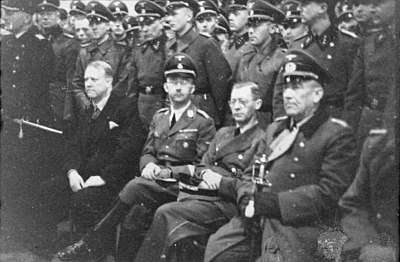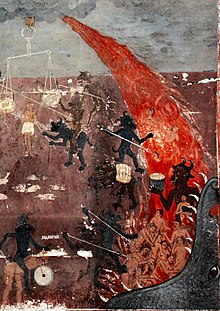Isengard
In J. R. R. Tolkien's fantasy writings, Isengard (/ˈaɪzənɡɑːrd/) is a large fortress in Nan Curunír, the Wizard's Vale, in the west of Middle-earth. It is supposedly a translation of Angrenost in the elvish language Sindarin, in reality from Old English, meaning "iron enclosure".
| Isengard | |
|---|---|
| J.R.R. Tolkien's legendarium location | |
 The Orcs of Isengard bore upon their shields the symbol of the White Hand on a black field. | |
| First appearance | The Fellowship of the Ring |
| Information | |
| Type | Fortress built to guard the Gap of Rohan |
| Ruler | Saruman |
| Notable locations | The Tower of Orthanc, the Ring of Isengard, the pillar of the White Hand, the Isen |
| Other name(s) | Angrenost, Nan Curunír, Wizard's Vale |
| Location | Calenardhon |
| Lifespan | Second Age – Fourth Age |
| Founder | Gondor, during the time of Isildur |
Orthanc, the tower at the centre of Isengard, was at the time of The Lord of the Rings the home of the Wizard Saruman. He had been ensnared by the Dark Lord Sauron through the tower's palantír, a far-seeing crystal ball able to communicate with others like it. Saruman had bred Orcs in Isengard, in imitation of Sauron's forces, ready for war with Rohan. The Orcs had cut many trees of the forest of the Ents, who had retaliated by destroying Isengard while the army of Orcs was away attacking Rohan at Helm's Deep, though they were unable to harm the tower of Orthanc. Saruman, isolated in the tower, was visited by some of the Fellowship; his staff was broken by the Wizard Gandalf.
Isengard has been described by scholars as an industrial hell, and as illustrating the homogeneity of evil, in contrast to the evident diversity of the free societies of Middle-earth including those of the Elves, Dwarves, and Gondor. It has been compared to Vichy France, and its proposed governor on behalf of Mordor, the Mouth of Sauron, to a traitorous Quisling.
Fictional history

Construction
The Númenóreans in exile built Isengard in the Second Age as a walled circular enclosure, with the tower of Orthanc at its centre. It lay just outside the north-western corner of Rohan, guarding the Fords of Isen from enemy incursions into Calenardhon together with the fortress of Aglarond to its south.[T 1]
The river Angren (or Isen) began on Methedras, the southernmost peak of the Misty Mountains. Methedras stood behind Isengard, forming its northern wall. The rest of its perimeter consisted of a large wall, the Ring of Isengard, breached only by the inflow of the river Angren at the north-east through a portcullis, and the gate of Isengard at the south, at both shores of the river. For most of its history, Isengard was a green and pleasant place, with many fruiting trees.[T 1]
Orthanc was built towards the end of the Second Age by men of Gondor from four many-sided columns of rock joined together by an unknown process and then hardened. No known weapon could harm it.[T 2] Orthanc rose to more than 500 feet (150 metres) above the plain of Isengard, and ended in four sharp peaks.[T 1][1] Its only entrance was at the top of a high stair, and above that was a small window and balcony.[T 3] It housed one of the palantíri of the South Kingdom, and was guarded by a warden.[T 4]
Depopulation
In the Third Age the land of Calenardhon became depopulated, and the last warden of Orthanc was recalled to Minas Tirith. Isengard remained guarded by a small company, led by a hereditary captain. Contact with Minas Tirith gradually decreased and eventually ceased altogether. When Cirion, Steward of Gondor, gave Calenardhon to the Éothéod, becoming the land of Rohan, Isengard was the sole fortress retained by Gondor north of the Ered Nimrais. The small guard intermarried much with the Dunlendings, until the fortress became Dunlending in all but name. The tower of Orthanc however remained locked and inaccessible to the Dunlendings, as the Steward of Gondor alone held the keys in Minas Tirith. The line of hereditary Captains died out, and during the rule of Rohan's King Déor, Isengard became openly hostile to the Rohirrim. Using Isengard as their base, the Dunlendings continually raided Rohan until during the rule of Helm Hammerhand, the Dunlending lord Freca and his son Wulf nearly managed to destroy the Rohirrim. The Rohirrim destroyed the invaders and blockaded Isengard, eventually taking it.[T 4]
Gondor did not wish to relinquish its claim to the tower, but lacked the strength to garrison it. A solution presented itself to the Steward of Gondor, Beren, as the Wizard Saruman suddenly reappeared from the East, offering to guard Isengard. Beren gladly gave him the keys to Orthanc. At first he resided there as Warden of the Tower on behalf of Gondor.[T 4] The valley became known as Nan Curunír, the "Wizard's Vale".[T 1] On Sauron's return to Mordor, Saruman asserted himself as Lord of Isengard.[T 1]
War of the Ring
During the War of the Ring, Saruman prepared for war against Rohan, defiling the valley of Isengard with deep pits where he bred large numbers of powerful warrior Orcs, Uruk-hai, smithing weapons in underground workshops full of machinery, and felling the valley's trees.[T 1]
The Orcs of Isengard bore upon their shields the symbol of a White Hand on a black field, and on their helmets an S-rune (![]()
Treebeard, leader of the Ents, seeing that the Orcs would destroy his forest of Fangorn, led an army of Ents and Huorns to Isengard, destroyed it, and flooded it, leaving Saruman isolated in the impervious tower of Orthanc.[T 2] The hobbits Merry Brandybuck and Pippin Took, as the new "doorwardens", received Théoden King of Rohan, Aragorn and the wizard Gandalf at the wrecked gates.[T 2] Gandalf spoke with Saruman and broke his staff. Grima Wormtongue threw the Orthanc palantír, a stone of seeing, at the party;[T 3] both Pippin and Aragorn later used it, seeing and deceiving Sauron as to the Fellowship's intentions.[2]
Saruman was then locked in Orthanc and guarded by Treebeard, but was later set free, turning the tower's keys over to Treebeard before leaving and taking Gríma with him. Treebeard's main reason for letting Saruman go was that he could not bear to see any living thing caged. Saruman exploited this weakness, most likely using his power with words.[T 7]
Restoration
During the Fourth Age, when Aragorn had been crowned as King Elessar ("Elfstone"), he visited Orthanc, finding there heirlooms of Isildur, among them the Elendilmir, the Star of Arnor, and the small gold case on a chain that Isildur had used to carry the One Ring, evidence that Saruman had found and apparently destroyed Isildur's remains.[T 8][3] Isengard was restored, and the entire valley granted to the Ents. The Ents named the new forest the Treegarth of Orthanc. Orthanc became again a tower of the Reunited Kingdom of Gondor and Arnor.[T 7]
Origins
Etymology
"Isengard" is from Old English īsen, "iron" and geard, "court, enclosure".[4] The names, supposedly given by the Rohirrim, for Orthanc, the cunningly-built tower of Isengard, and for the Ents, the tree-giants of Fangorn forest who eventually destroy Isengard, are similarly in reality from Old English. Both are found in the poem The Ruin, which describes the ancient Roman ruins as orþanc, "skilful work", and enta geweorc, "the work of giants".[5] Clark Hall gives the meanings of the noun orþanc as "intelligence, understanding, mind; cleverness, skill; skilful work, mechanical art", and as an adjective "ingenious, skilful".[6] The Tolkien critic Tom Shippey suggests that Tolkien may have chosen to read the phrase also as "Orthanc, the Ent's fortress".[7] Orthanc is said to mean "Mount Fang" in Sindarin.[7]
Illustrations
Tolkien made detailed sketches of Isengard and Orthanc, published in J. R. R. Tolkien: Artist and Illustrator, as he developed his conception of them.[9]
Interpretations
Industrial hell
The scholar of English literature Charles A. Huttar describes Isengard as an "industrial hell".[8] He quotes Tolkien's description of Isengard, supplying his own emphasis on Tolkien's words: "tunneled .. circle .. dark .. deep .. graveyard of unquiet dead .. the ground trembled .. treasuries .. furnaces .. iron wheels .. endlessly .. lit from beneath .. venomous."[T 9][8] Huttar comments: "The imagery is familiar, its connotations plain. This is yet another hell [after Moria and Mordor]."[8] All the same, he writes, the tower of Orthanc cannot but be admired, with its "marvellous shape" and wonderful, ancient strength; he supposes that for Tolkien, technology could neither be "wholeheartedly embraced nor utterly rejected".[8]
Shippey, discussing Saruman's character, notes several facts about him: Treebeard's comment that "He has a mind of metal and wheels"; that Isengard means "Irontown"; that the Ents are attacked in Isengard with "a kind of napalm [or] perhaps ... [given] Tolkien's own experience, a Flammenwerfer".[10] Shippey concludes that Saruman had been led into "wanton pollution ... by something corrupting in the love of machines",[10] which he connects to "Tolkien's own childhood image of industrial ugliness ... Sarehole Mill, with its literally bone-grinding owner".[10]
David D. Oberhelman, writing in the J.R.R. Tolkien Encyclopedia, states, following Anne C. Petty, that there are multiple "industrial 'hells' in Tolkien's work, such as Saruman's blighted, machine-ridden Isengard".[11][12] He notes that its prototype was the fallen Vala Morgoth's subterranean fortress, Angband, whose name meant "Iron Prison" or "Hell of Iron".[11]
Vichy status

Isengard is the promised reward for the nameless "Mouth of Sauron", as soon as Gondor and its allies had surrendered. In his words in front of the Black Gate:[T 10]
West of the Anduin as far as the Misty Mountains and the Gap of Rohan shall be tributary to Mordor, and men there shall bear no weapons, but shall have leave to govern their own affairs. But they shall help to rebuild Isengard which they have wantonly destroyed, and that shall be Sauron's, and there his lieutenant shall dwell: not Saruman, but one more worthy of trust.[T 10]
Shippey compares Sauron's offer to the Vichy treaty imposed on France after its surrender in 1940: "sovereignty over the disputed territory of Ithilien [East of the Anduin], the Alsace-Lorraine of Middle-earth, is to be transferred", and in the lands to the West "a demilitarized zone, with what one can only call Vichy status, which will pay war-reparations, and be governed [from Isengard] by what one can again only call a Quisling."[13]
Homogeneity of evil
During the War of the Ring, Isengard was controlled by Saruman until the fortress's destruction, but Saruman had become "more like Sauron than he realizes",[14] like him believing in "supremacy through absolute power",[14] and unintentionally a pupil of Sauron, having against Elrond's advice "stud[ied] too deeply the arts of the enemy".[14] The Tolkien scholars Wayne Hammond and Christina Scull note that the palantír in Orthanc had formed what Gandalf called "some link between Isengard and Mordor, which I have not yet fathomed": the link was that Sauron had used the stone to take control of Saruman, and through him his forces of Orcs.[15] In The Two Towers, Tolkien himself described Saruman's Isengard as "only a little copy, a child's model or a slave's flattery ... [of Sauron's] vast fortress, armoury, prison, furnace of great power, Barad-dûr."[T 1] The Tolkien scholar Brian Rosebury writes that Tolkien was making the point that whereas good government in free societies like those of Gondor, the Dwarves, the Elves, the Drúedain, and the Shire leads to diversity, "evil tends to homogeneity".[16]
Adaptations
In Peter Jackson's films of The Lord of the Rings, Isengard and Orthanc were based on Alan Lee's illustrations and modelled under the direction of Richard Taylor;[1] Lee worked as the project's conceptual artist in New Zealand throughout the making of the film trilogy.[17] The very large miniature or "bigature" of Orthanc was cast and then carved from micro-crystalline wax to resemble obsidian, black volcanic glass; it was made at 1/35 scale, standing some 15 feet (4.6 m) high. The model of the walled circular area of Isengard was more than 65 feet (20 m) wide.[1]
References
Primary
- This list identifies each item's location in Tolkien's writings.
- Tolkien 1954, book 3 ch. 8, "The Road to Isengard"
- Tolkien 1954, book 3 ch. 9, "Flotsam and Jetsam"
- Tolkien 1954, book 3 ch. 10, "The Voice of Saruman"
- Tolkien 1955, Appendix A, II "The House of Eorl"
- Tolkien 1954, book 3 ch. 1, "The Departure of Boromir": "Upon their shields they bore a strange device: a small white hand in the centre of a black field; on the front of their iron helms was set an S-rune, wrought of some white metal"
- Tolkien 1954, book 3 ch. 2, "The Riders of Rohan": "Great Orcs, who also bore the White Hand of Isengard"
- Tolkien 1955, book 6 ch. 6, "Many Partings"
- Tolkien 1980, Part 3, ch. 1 "Disaster of the Gladden Fields"
- Tolkien 1954, book 3, ch. 8 "The Road to Isengard"
- Tolkien 1954, book 3, ch. 10 "The Black Gate Opens"
Secondary
- Svitil 2007, pp. 75–76.
- Shippey 2005, pp. 188, 423-425.
- Libran Moreno 2013, pp. 146–147.
- Clark Hall 2002, pp. 149, 207.
- Cusack 2011, p. 172.
- Clark Hall 2002, p. 270.
- Shippey 2001, p. 88.
- Huttar 1975, pp. 135–137.
- Hammond & Scull 1995, pp. 166–171, and plates 162–165.
- Shippey 2005, p. 194.
- Oberhelman 2013, p. 18.
- Petty 2003, p. 63.
- Shippey 2001, p. 166.
- Kocher 1974, p. 63.
- Hammond & Scull 2005, p. 432.
- Rosebury 2016, pp. 39-40.
- Barnett, David M. (3 September 2018). "Making fantasy reality: Alan Lee, the man who redrew Middle-earth". The Guardian.
Sources
- Clark Hall, J. R. (2002) [1894]. A Concise Anglo-Saxon Dictionary (4th ed.). University of Toronto Press.
- Cusack, Carole M. (2011). The Sacred Tree: Ancient and Medieval Manifestations. Cambridge Scholars Publishing. ISBN 978-1-4438-3031-7.
- Libran Moreno, Miryam (2013) [2007]. "Elendilmir". In Drout, Michael D. C. (ed.). J.R.R. Tolkien Encyclopedia: Scholarship and Critical Assessment. Routledge. pp. 146–147. ISBN 978-0-415-86511-1.
- Hammond, Wayne G.; Scull, Christina (1995). J. R. R. Tolkien: Artist and Illustrator. HarperCollins. ISBN 0-261-10322-9.
- Hammond, Wayne G.; Scull, Christina (2005). The Lord of the Rings: A Reader's Companion. HarperCollins. ISBN 978-0-00-720907-1.
- Huttar, Charles A. (1975). Lobdell, Jared (ed.). A Tolkien Compass. Open Court. ISBN 978-0875483030.
- Kocher, Paul (1974) [1972]. Master of Middle-Earth: The Achievement of J.R.R. Tolkien. Penguin Books. ISBN 978-0-14-003877-4.
- Oberhelman, David D. (2013) [2007]. "Angband". In Drout, Michael D. C. (ed.). J.R.R. Tolkien Encyclopedia: Scholarship and Critical Assessment. Routledge. pp. 17–18. ISBN 978-0-415-86511-1.
- Petty, Anne C. (2003). Tolkien in the Land of Heroes: Discovering the Human Spirit. Cold Spring Press. ISBN 978-1892975997.
- Rosebury, Brian (2016). Tolkien: A Critical Assessment. Springer. ISBN 978-1-349-22133-2.
- Shippey, Tom (2001). J. R. R. Tolkien: Author of the Century. Houghton Mifflin. ISBN 978-0-618-12764-1.
- Shippey, Tom (2005) [1982]. The Road to Middle-Earth (Third ed.). Grafton (HarperCollins). ISBN 978-0261102750.
- Svitil, Torene (2007). So You Want to Work in Animation & Special Effects?. Enslow Publishers. ISBN 978-0-7660-2737-4.
- Tolkien, J. R. R. (1954). The Two Towers. Houghton Mifflin. ISBN 0-395-08254-4.
- Tolkien, J. R. R. (1955). The Return of the King. Houghton Mifflin. ISBN 0-395-08256-0.
- Tolkien, J. R. R. (1980). Christopher Tolkien (ed.). Unfinished Tales. Houghton Mifflin. ISBN 0-395-29917-9.



.jpg)